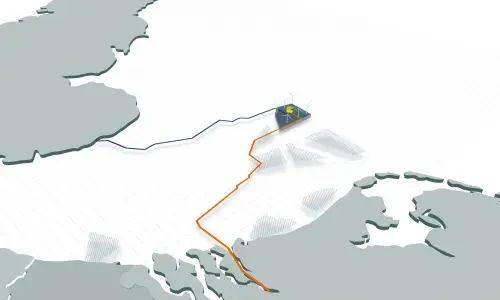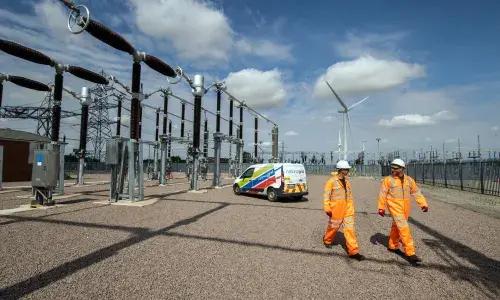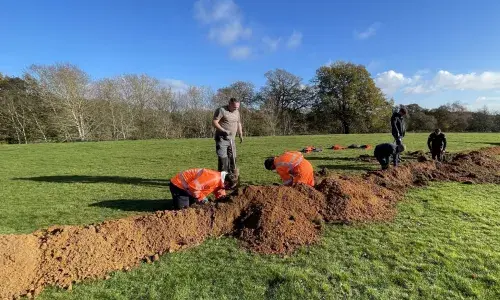
National Grid announces preferred route for pipelines to decarbonise Humber industry
- National Grid Ventures’ Humber Low Carbon Pipelines project will transport both low carbon hydrogen and carbon emissions captured locally for safe storage.
- Decarbonising industry will protect and create thousands of jobs across the region and bring environmental benefits.
National Grid Ventures, part of National Grid plc, has today announced the preferred route for its Humber Low Carbon Pipelines (HLCP) project, which will run for 120km from the Drax power station in Selby to Easington on the Holderness coast.
HLCP aims to deliver vital new infrastructure to decarbonise local industry and establish the Humber region, which currently accounts for 40% of all carbon dioxide (CO2) emissions from industrial clusters, as a globally competitive hub for green products and services.
HLCP will create an onshore network of underground pipelines to transport captured CO2 emissions from emitters to safe storage under the North Sea and enable local energy-intensive industries to switch from fossil fuels to low carbon hydrogen. Decarbonising local industry could play a vital role in helping to protect 55,000 skilled manufacturing jobs in the region in the next decade and put the Humber at the forefront of the UK’s journey to net zero.
Following a public consultation in autumn 2021, National Grid Ventures has identified a preferred route corridor for the proposed network of onshore pipelines. The route corridor incorporates feedback from local communities and stakeholders, as well as a careful research, analysis and review of environmental and technical considerations.
The preferred route corridor is a 500m wide area, which from will cross beneath the Humber via a newly built tunnel and pass through Keadby and the planned SSE power station.
HCLP is part of the East Coast Cluster, which aims to deliver the onshore and offshore transport and storage infrastructure needed to decarbonise industry across the Humber and Teesside. In October 2021, the East Coast Cluster was selected by the Government as one of the UK’s first two carbon capture, usage and storage (CCUS) clusters to be operational by middle of the decade.
Andy Benjamin, Director of CCUS for National Grid Ventures said: “As the UK’s largest industrial cluster, the Humber region has a long and proud heritage in industry and power generation.
By working with the community and local partners, we want to develop the infrastructure needed to transform the Humber region into a hub for green products and services, protecting and creating thousands of skilled jobs for current and future generations.
"We’ll be running more events in the coming months to enable local people along the route to hear about our plans, ask us questions and give us their views.”
For more information, please contact:
Sara Revell
Press Officer
National Grid Ventures
M: +44 (0) 74743962
E: [email protected]
The project
Our proposals are to create an onshore network of underground pipelines for the Humber region to transport captured carbon dioxide (CO2) and hydrogen. Together, these pipelines will help the Humber region to decarbonise, supporting a low carbon future, the region’s economy and the UK’s vision for net zero by 2050.
Our proposed pipeline network will comprise two underground pipelines – one for CO2 and the other for hydrogen.
The pipelines are intended to connect to major industrial emitters and power stations in the Humber region, such as Drax, the new power station at Keadby, British Steel in Scunthorpe, Uniper’s Killingholme site near Immingham and Equinor’s proposals for hydrogen production at Saltend.
The pipelines will continue to a landfall point on the Holderness coast. The onshore carbon dioxide pipeline will then connect via an offshore pipeline to the Endurance offshore storage location.
The project will also include a number of above ground installations and a tunnel under the River Humber.
Hydrogen could provide a clean source of fuel and heat for our homes, transport and industry. As set out in the UK Hydrogen Strategy, the Government is aiming for 5GW of low carbon hydrogen production capacity by 2030.
Carbon capture, usage and storage (CCUS) technology will play a critical role in helping the UK to achieve net zero by capturing CO2 emissions and storing them safely. The UK is planning for several CCUS clusters over the next decade, capturing up to 10 million tonnes (Mt) of CO2 per year by 2030. The Government’s initial aim is to deploy CCUS in two industrial clusters by the mid-2020s.
About National Grid Ventures
- National Grid Ventures operates outside of National Grid’s core regulated businesses in the UK and US where it develops, operates and invests in energy projects, technologies and partnerships to accelerate the development of our clean energy future.
- National Grid Ventures operates a diverse portfolio of energy assets across the UK and US, including subsea electricity interconnectors, competitive transmission, wind and solar generation, battery storage and LNG storage and regasification.
National Grid in the UK
- We own and operate the electricity transmission network in England and Wales, with day-to-day responsibility for balancing supply and demand. We also operate, but do not own, the Scottish networks. Our networks comprise approximately 7,200 kilometres (4,474 miles) of overhead line, 1,500 kilometres (932 miles) of underground cable and 342 substations.
- We own and operate the gas National Transmission System in Great Britain, with day-to-day responsibility for balancing supply and demand. Our network comprises approximately 7,660 kilometres (4,760 miles) of high-pressure pipe and 618 above-ground installations.
National Grid undertakes no obligation to update any of the information contained in this release, which speaks only as at the date of this release, unless required by law or regulation.


